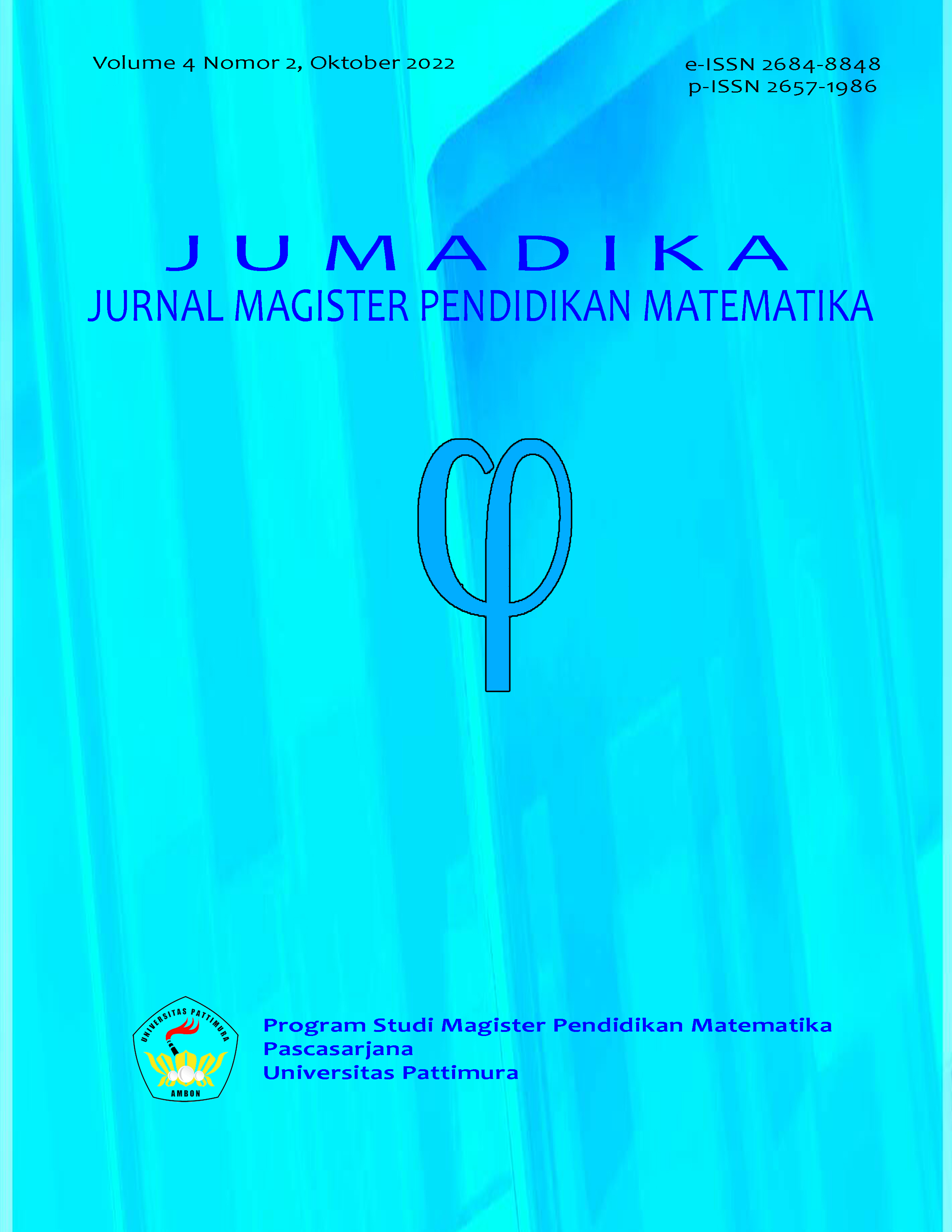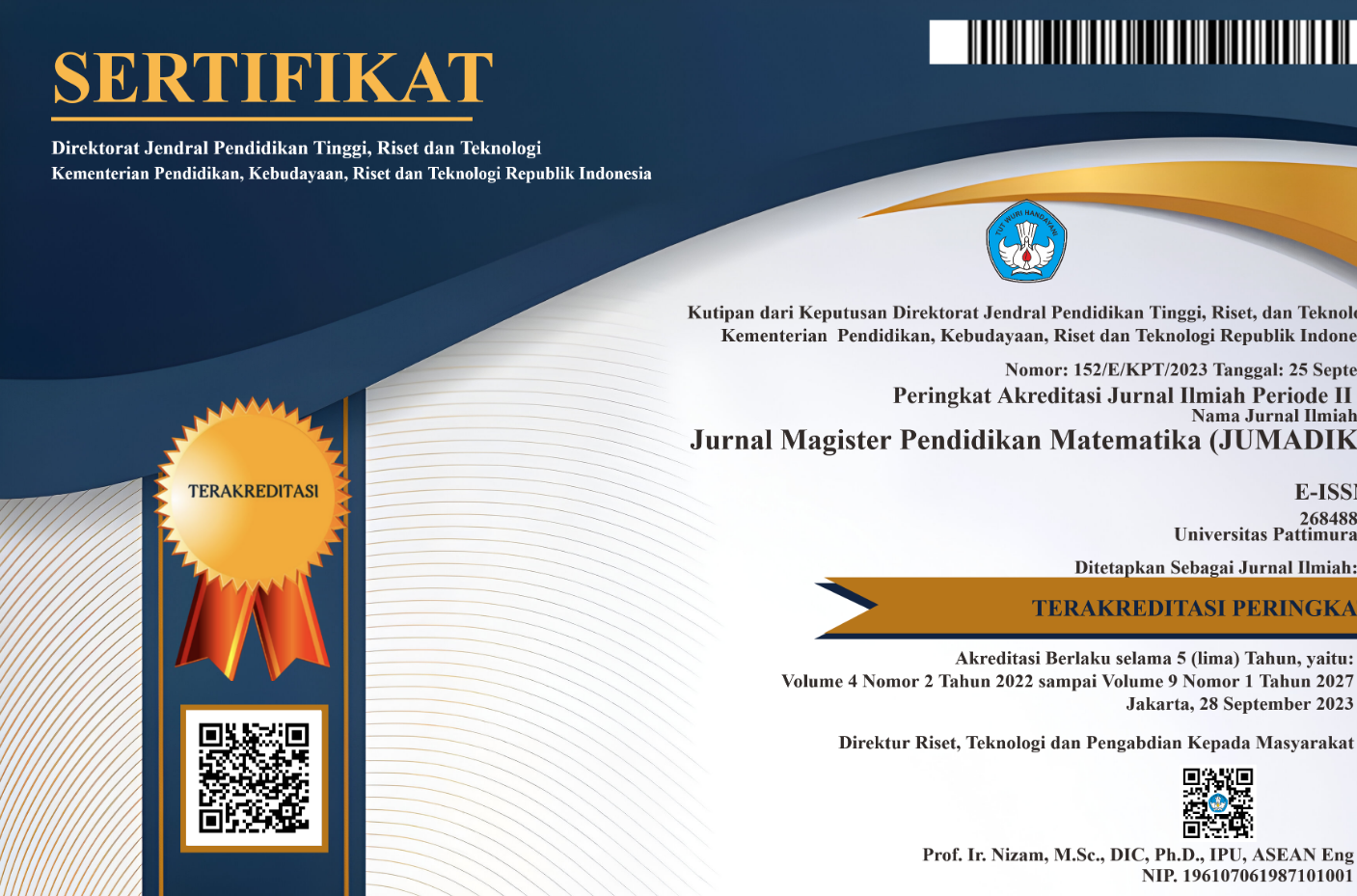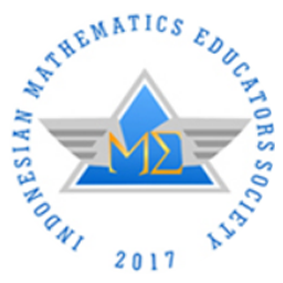ANALISIS KEMAMPUAN LITERASI NUMERASI MAHASISWA DITINJAU DARI GAYA KOGNITIF REFLEKTIF DAN IMPULSIF
Abstract
During the Covid-19 pandemic, there was a change in the education system, namely regular or face-to-face Numerical literacy ability is the ability or skill in using various kinds of numbers and symbols related to basic mathematics to solve practical problems in the context of everyday life. This study aims to determine the numeracy literacy ability of students in solving math problems in terms of reflective and impulsive cognitive styles. In looking at students' numeracy literacy skills, indicators of numeracy literacy abilities are used which are adjusted to the stages of the problem solving process. This research is a descriptive research with a qualitative approach. The research subjects consisted of 23 students of the Mathematics Education Study Program at the University of Papua. Data collection consisted of a numeracy literacy test, an MFFT (Matching Familiar Figure Test) test to determine cognitive style, interviews and documentation. The results of the MFFT test showed that there were 11 students with a reflective cognitive style, 9 students with an impulsive cognitive style, 1 student with a low accurate cognitive style, and 2 students with a fast accurate cognitive style. After that, 2 subjects with a reflective cognitive style were obtained which were supported by 2 subjects who had a tendency for a reflective cognitive style and 2 subjects who had an impulsive cognitive style. The results showed that the reflective subject one (SR1) the first reflective student completed the numeracy literacy problem in 91 minutes and the reflective subject two (SR2) completed the problem in 98 minutes, where the two subjects with the minute reflective style had exceeded the predetermined maximum time limit, namely 90 minutes. Impulsive subject one (SI1) completed the numeracy literacy test in 32 minutes. The second impulsive subject (SI2) completed the numeracy literacy test questions within 40 minutes. The two students completed it faster than the specified time limit of 90 minutes. Subjects with a cognitive-reflective style in solving problems take a long time but the results obtained tend to be correct or accurate, while subjects with an impulsive cognitive style seem to be in a hurry to answer and tend to be wrong
Downloads
References
Abidin, Y., Mulyati, T., & Yunansah, H. (2017). Strategi meningkatkan kemampuan literasi matematika, sains, membaca dan menulis. Jakarta: Bumi Aksara.
Efendi, I. (2022). Analisis Literasi Numerasi dalam Menyelesaikan Soal High Order Thinking Skill (HOTS) pada Siswa Kelas VIII SMP Negeri 2 Barombong. Makassar: Universitas Negeri Makassar.
Ghony, M. D., & Almanshur, F. (2017). Metodologi Penelitian Kualitatif. Jogjakarta: Ar-Ruzz Media.
Han, W., Susanto, D., Dewayani, S., Pandora, P., Hanifah, N., Miftahussururi, M., Akbari, Q. S. (2017). Materi pendukung literasi numerasi. Jakarta: Kemdikbud.
Imama, M., & Siswono, T. E. (2017). Proses Berpikir Siswa SMP dalam Mengajukan Masalah Matematika. Jurnal Ilmiah Pendidikan Matematika, 2 (6), 2017.
Inanna, I. (2018). Peran Pendidikan dalam Membangun Karakter Bangsa yang Bermoral. Jurnal Ekonomi dan Pendidikan, 1 (1), 27-33.
Khasmawati, H., Waluya, S. B., & Asikin, M. (2022). Self Confidence Siswa dalam Memecahkan Soal Serupa Pisa Berkonten Changes and Relationships. Jurnal Magister Pendidikan Matematika (JUMADIKA), 4 (1), 1-7.
Mahmud, M. R., & Pratiwi, I. M. (2019). Literasi Numerasi Siswa dalam Pemecahan Masalah. KALAMATIKA Jurnal Pendidikan Matematika, 4 (1). 69-88.
Nurdianasari, H. (2015). Analisis Kemampuan Literasi Matematika Siswa Kelas VIII Berdasarkan Gaya Kognitif dalam Pembelajaran PMRI. Semarang: Universitas Negeri Semarang.
OECD. (2018). PISA 2018 Results. (Online), (http://www.oecd.org/pisa), diakses pada 11 Juli 2022.
Patta, R., Muin, A., & Mujahidah, M. (2021). Kemampuan literasi numerasi ditinjau dari gaya kognitif reflektif-impulsif. JIKAP PGSD: Jurnal Ilmiah Ilmu Kependidikan, 5 (2), 212-217.
Perdana, R., & Suswandari, M. (2021). Literasi Numerasi Dalam Pembelajaran Tematik Siswa Kelas Atas Sekolah Dasar. Absis: Mathematics Education Journal, 3 (1), 9-15.
Putra, N. (2013). Metode Penelitian Kualitatif Pendidikan. Jakarta: PT Raja Grafindo Persada.
Putri, E. S., Yusmin, E., & Nursangaji, A. (2021). Analisis Literasi Numerasi pada Materi Persamaan dan Pertidaksamaan Nilai Mutlak Linear Satu Variabel Dikaji dari Kecerdasan Emosional. Jurnal AlphaEuclidEdu, 2 (2), 174-183.
Salvia, N. Z., Sabrina, F. P., & Maula, I. (2022). Analisis Kemampuan Literasi Numerasi Peserta Didik Ditinjau dari Kecemasan Matematika. Prosandika UNIKAL (Prosiding Seminar Nasional Pendidikan Matematika Universitas Pekalongan) (pp. 351-360). Pekalongan: Universitas Pekalongan.
Simalango, M. M., Darmawijoyo, D., & Aisyah, N. (2018). Kesulitan Siswa dalam Menyelesaikan Soal-soal PISA pada Konteks Change and Relationship Level 4, 5, dan 6 di SMPN 1 Indralaya. Jurnal Pendidikan Matematika, 12 (1), 43-58.
Sudarwono, E. T. (2020). Penguasaan 4 (Empat) Prasyarat Dasar Aritmatika Untuk Meningkatkan Kemampuan Siswa Sekolah Dasar dalam Menyelesaikan Soal Matematika. Jurnal Pembelajaran dan Matematika Sigma, 6 (2), 72-84.
Sugiyono. (2015). Metode Penelitian Pendidikan : Pendekatan Kuantitatif, Kualitatif, dan R & D. Bandung: Alfabeta.
Warli. (2014). Kreativitas Siswa SMP yang bergaya Kognitif Reflektif atau Impulsif dalam Memecahkan Masalah Geometri. Jurnal Pendidikan dan Pembelajaran (JPP), 20 (2), 190-201.
Wulan, N., Sukmawati, B., & Baharullah. (2021). Analyzing Mathematical Literacy Abilities in Terms of Cognitive Style of Sixth Grade Students: a Case Study at SD Inpres Nipa-Nipa. Jurnal PAJAR (Pendidikan dan Pengajaran), 5 (4), 1065-1078
Copyright (c) 2022 Ebeneser Wacner Simamora, Akhiruddin Akhiruddin

This work is licensed under a Creative Commons Attribution-NonCommercial-ShareAlike 4.0 International License.
License and Copyright Agreement
In submitting the manuscript to the journal, the authors certify that:
- They are authorized by their co-authors to enter into these arrangements.
- The work described has not been formally published before, except in the form of an abstract or as part of a published lecture, review, thesis, or overlay journal. Please also carefully read Jurnal Magister Pendidikan Matematika (JUMADIKA) Posting Your Article Policy.
- That it is not under consideration for publication elsewhere,
- That its publication has been approved by all the author(s) and by the responsible authorities – tacitly or explicitly – of the institutes where the work has been carried out.
- They secure the right to reproduce any material that has already been published or copyrighted elsewhere.
- They agree to the following license and copyright agreement.
Copyright
Authors who publish with Jurnal Magister Pendidikan Matematika (JUMADIKA) agree to the following terms:
- Authors retain copyright and grant the journal right of first publication with the work simultaneously licensed under a Creative Commons Attribution-NonCommercial-ShareAlike 4.0 International License (http://creativecommons.org/licenses/by-nc-sa/4.0/) that allows others to share the work with an acknowledgment of the work's authorship and initial publication in this journal.
- Authors are able to enter into separate, additional contractual arrangements for the non-exclusive distribution of the journal's published version of the work (e.g., post it to an institutional repository or publish it in a book), with an acknowledgment of its initial publication in this journal.
- Authors are permitted and encouraged to post their work online (e.g., in institutional repositories or on their website) prior to and during the submission process, as it can lead to productive exchanges, as well as earlier and greater citation of published work.








